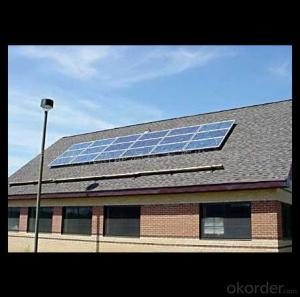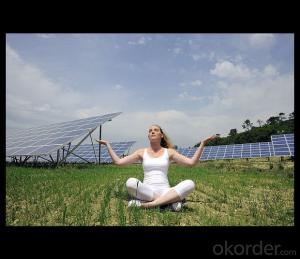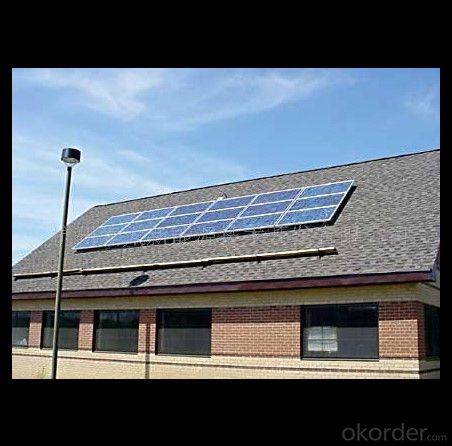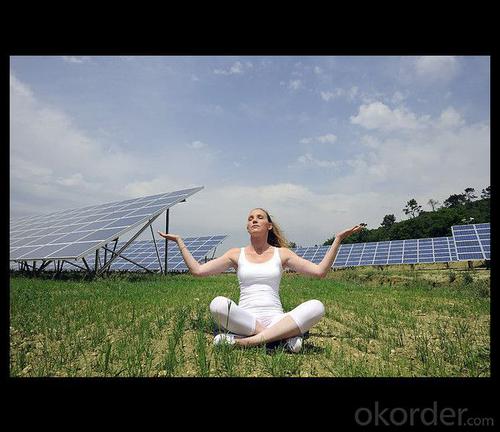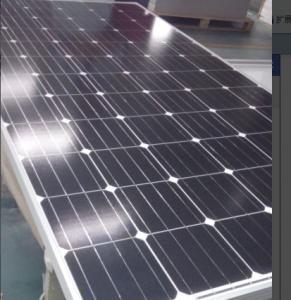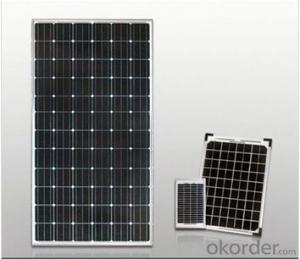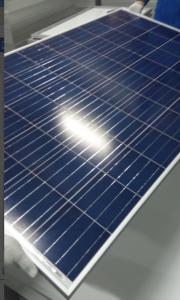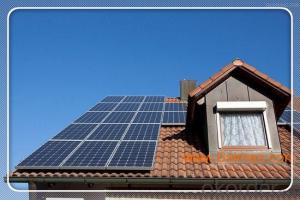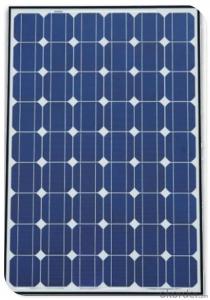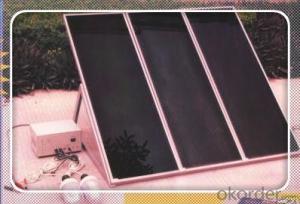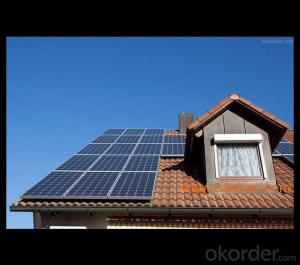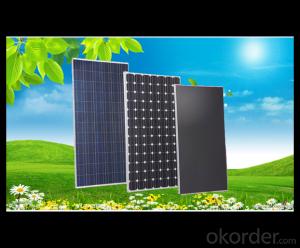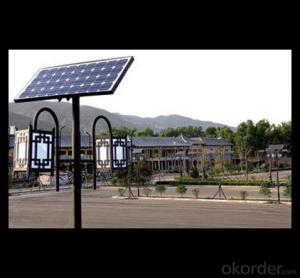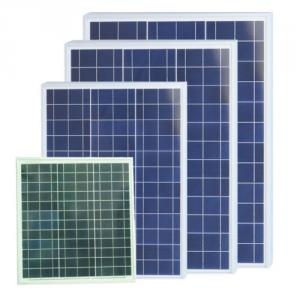Wall of Solar Panels:285w Direct Factory Sale Price 260-300watt Solar Panels
- Loading Port:
- China main port
- Payment Terms:
- TT OR LC
- Min Order Qty:
- 10000 watt
- Supply Capability:
- 100000 watt/month
OKorder Service Pledge
OKorder Financial Service
You Might Also Like
Specification
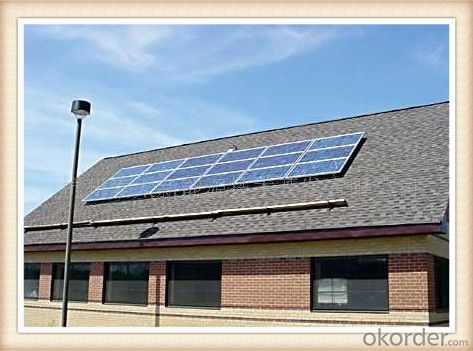
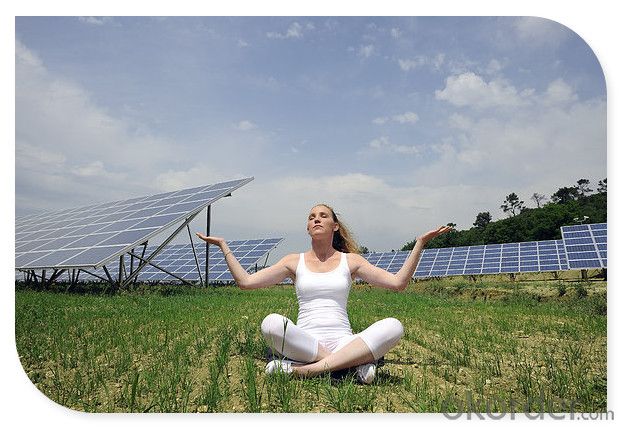
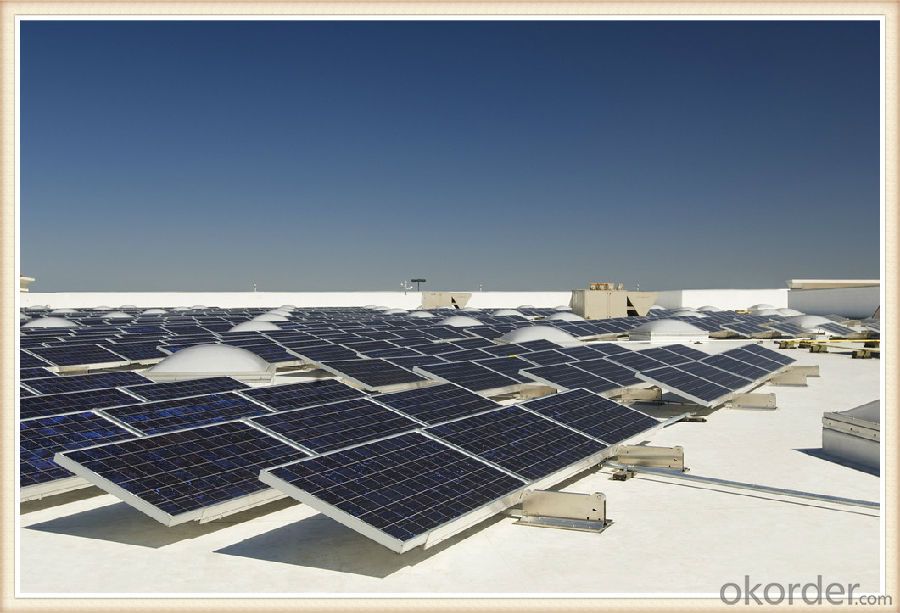
Solar Module Introduction
Solar modules use light energy (photons) from the sun to generate electricity through the photovoltaic effect. The majority of modules use wafer-based crystalline silicon cells or thin-film cells based on cadmium telluride or silicon. The structural (load carrying) member of a module can either be the top layer or the back layer. Cells must also be protected from mechanical damage and moisture. Most solar modules are rigid, but semi-flexible ones are available, based on thin-film cells. These early solar modules were first used in space in 1958.
Electrical connections are made in series to achieve a desired output voltage and/or in parallel to provide a desired current capability. The conducting wires that take the current off the modules may contain silver, copper or other non-magnetic conductive transition metals. The cells must be connected electrically to one another and to the rest of the system. Externally, popular terrestrial usage photovoltaic modules use MC3 (older) or MC4 connectors to facilitate easy weatherproof connections to the rest of the system.
Specification
Model Type | |
Peak Power-Pmax(W) | 5-200W |
Open Circuit Voltage-Voc(V) | 44.2 |
Maximum Power Voltage-Vmp(V) | 36 |
Short Circuit Current-Isc(A) | 5.4 |
Maximum Power Current-Imp(A) | 5 |
Maximum System Voltage | 1000V DC |
Maximum Series Fuse Rating | 10A |
Power Tolerance | -1~+3% |
Temperature Coefficients of Pmax | -0.45%/℃ |
Temperature Coefficients of Voc | -0.348%/℃ |
Temperature Coefficients of Isc | 0.031%/℃ |
Nominal Operating Cell Temperature | 44.5±2℃ |
Standard Testing Condition(STC) | Irradiance:1000W/m²;Temperature:25℃;AM=1.5 |
Qualification Test Parameters | |
Operating Temperature | -40℃~+85℃ |
Storage Temperature | -40℃~+85℃ |
Pressure Bearing | ≥5400Pascal/m² |
Wind Bearing | ≥5400Pascal/m² |
Mechanical Characteristics | |
Cell Size | Mono 125*125mm±0.5 |
No.of Cells | 72pcs(6*12) |
Dimension | 1580*808*40mm |
Weight | 15.5Kg |
Glass | 3.2mm High Transmission,Low Iron |
Frame | Anodized Aluminum Alloy |
Junction Box | IP65Rated |
Internal Diodes | 3 Bypass Diodes |
Cable | 1*4.0mm² Length 900mm |
Images
Packing & Shipping:
We have rich experience on how to pack the panels to make sure the safety on shipment when it arrives at the destination.
The normal size is packed by 25pcs/ carton / pallet. Paper carton for FCL shipping and wood carton for LCL shipping.
Features
1.High reliability with guaranteed -3% to +5% power output tolerance, ensuring return on investment
2.High conversion efficiency based on leading innovative photovoltaic technologies
3.Withstands high wind-pressure and snow load, and extreme temperature variations
4.Attractive appearanceUnique frame design, high mechanical strength, and easy Installation
Warranty:
For c-Si panel: 25years output warranty for no less than 80% of performance, 10 years output warranty for no less than 90% of performance. Free from material and workmanship defects within 5 years.
For a-Si panel: 20 years output warranty for no less than 80% of performance, 10 years output warranty for no less than 90% of performance. Free from material and workmanship defects within 2 years.
•100% product quality protection
•100% on-time shipment protection
•100% payment protection for your covered amount
FAQ:
(1)What price for each watt?
It depends on the quantity, delivery date and payment terms.
(2)What is your size for each module? Can you tell me the Parameter of your module?
We have different series of panels in different output, both c-Si and a-Si. Please take the specification sheet for your reference.
(3)Can you provide the peripheral products of the solar panels, such as the battery, controller, and inverter? If so, can you tell me how do they match each other?
Actually we are only manufacturer of solar panels, but we could try to source them for you in China if you need. We could provide you an optimal system design to instruct you how to install.
(4)Do you have the CE, TUV, UL Certification?
We’ve already passed all the tests, and any certificate is available.
(5)Have you ever sold your products to companies in my country?
Of course, we have customers in all general PV markets, but I think we should expand our market share along with the market growth.
(6)When did your company set up? You are a new company, how can I believe your quality?
We entered into Solar PV industry in 2005, now we have several plants in manufacturing of a-Si and c-Si panels, and our capacity is 220MW per year. Till now we have already passed all the tests by authorized laboratories, e.g. TUV, VDE, UL.
(7)Can you help us install the module if we cooperate with you?
We haven’t entered into installation sector, but we have the plan in near future.
(8) How do you pack your products?
We have rich experience on how to pack the panels to make sure the safety on shipment when it arrives at the destination.
(9) Can you do OEM for us?
Yes, we can.
(10)Can we visit your factory?
Surely, I will arrange the trip basing on your business schedule.
- Q: I have:4- 5v 200ma solar panels5- 3v ,000ma solar panels- 7amp charge controller- 400watt inverterNow I have all my solar panels linked in series which in theory should give me 35v, 5.8 amps at 203 watts. Is this correct?The main question is, what kind of battery should I get so I can run my miscellaneous electronics off of it?I may not have explained it so well so if you need more information, feel free to ask.
- I okorder and they have deep cycle batteries exclusively made for solar panels. but in theory you should get more than one because it only takes around 4-5 volts to charge the battery and you do not want to have it that high even with a charge controller which i would also recommend getting which is like $50 on OKorder but a charge controller is used so you do not overcharge the batteries and fry them or undercharge the batteries and weaken its life it gets it just perfect. it lets the current go in and when it is charged fully nothing goes in an nothing comes out.... for a inverter the one i was going to get was $70 500 watt inverter but changes it from dc to ac...hope i helped
- Q: I am told there are night vision goggles to see at night due to invisible light still hitting earth. I am also told that there are other beams, x-rays etc hitting earth.Why couldn't they invent a solar panel with dual power in the day?It could harness both visible and invisible light, and at night be single?Anyone know why they can't make an invisible light solar panel?Is this possible?What happens if future cars have night vision windshields instead of lights?
- No night vision takes star light and intensifies it by 30,000 times.
- Q: Can solar panels be used in areas with high levels of bird droppings?
- Yes, solar panels can be used in areas with high levels of bird droppings. However, regular cleaning and maintenance may be required to ensure optimal performance of the solar panels and prevent any potential damage or obstruction caused by the bird droppings.
- Q: I'm looking for some advice on hot water solar panels. I'm trying to save some money on electricity. A neighbor has been suggesting solar powered equipment for some time now, and I think he's right. It does save quite a bit of money in the long run. They're kind of expensive though, so I'm looking for cheaper alternatives.
- Solar Power is great. I installed it myself about 2 years ago, and you really do notice the change within the first couple months. Building it yourself is actually pretty tricky without the right resources. Some of the guides don't have enough detailed information that you need when you start putting the project together. I was having a lot of trouble until I stumbled upon a site that was offering some great resources for solar DIY projects. I went ahead and added it to the sources section below. It's great and has everything you would need for putting your own solar projects together, including hot water solar panels. Hope this helps!
- Q: Can solar panels power my entire home?
- Yes, solar panels can potentially power your entire home depending on various factors such as the size of your system, energy consumption, and geographical location. It is important to assess your energy needs, install an appropriately sized solar system, and consider factors like sunlight availability to ensure sufficient power generation.
- Q: How do solar panels affect the overall sustainability of a building?
- Solar panels can significantly improve the overall sustainability of a building by generating clean and renewable energy. By harnessing the power of the sun, solar panels reduce the reliance on fossil fuels and minimize greenhouse gas emissions, helping to combat climate change. Additionally, solar panels can lower energy costs, enhance energy independence, and contribute to a more resilient and eco-friendly infrastructure.
- Q: How do solar panels affect roof warranty?
- Solar panels can potentially affect roof warranty, as their installation involves drilling holes into the roof and attaching the panels. This may void certain aspects of the roof warranty, especially those related to leaks or damage caused by the installation. It is important to review the terms of the roof warranty and consult with a professional installer to understand the specific impact solar panels may have on the warranty.
- Q: Is it good? ( solar energy)
- It depends mainly on where you live - both politically and geographically. It's very worthwhile if you live in the Southern hemisphere and your house faces north. The same holds true if you live in the Northern hemisphere in a south-facing dwelling. If your government gives a generous rebate towards your purchase of the panels (as the Australian one does) then ,yes, it is worthwhile as you can make your money back in only a few years. Of course if your motivation is more an ecologic than economic one then go ahead and do it.
- Q: Can solar panels be used for powering a wastewater treatment plant?
- Yes, solar panels can be used to power a wastewater treatment plant. Solar energy is a sustainable and renewable source of power that can be harnessed to generate electricity for various applications, including wastewater treatment. By installing solar panels, the plant can reduce its reliance on conventional electricity sources and lower its carbon footprint. However, the feasibility of using solar panels for powering a wastewater treatment plant may depend on factors such as the plant's energy requirements, available space for solar panel installation, and local climate conditions.
- Q: How are solar panels made?
- Solar panels are made using a multi-step process that involves the production of silicon wafers, the application of various layers and coatings, and the assembly of individual cells into a panel.
Send your message to us
Wall of Solar Panels:285w Direct Factory Sale Price 260-300watt Solar Panels
- Loading Port:
- China main port
- Payment Terms:
- TT OR LC
- Min Order Qty:
- 10000 watt
- Supply Capability:
- 100000 watt/month
OKorder Service Pledge
OKorder Financial Service
Similar products
Hot products
Hot Searches
Related keywords
